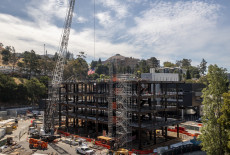Perlmutter Supports CO2 Fixation for Carbon-Negative Building Materials
Science Highlight
April 11, 2024
By Elizabeth Ball
Contact: cscomms@lbl.gov

Locking greenhouse gases into carbon nanofibers (CNFs) could turn buildings into carbon-storage devices.
Science Breakthrough
Researchers at Brookhaven National Laboratory and Columbia University used NERSC systems to advance their work on incorporating carbon dioxide (CO2) – a potent greenhouse gas – into carbon nanofibers (CNFs) that could be locked into construction materials and stored there for the lifetime of a building. Their work was published in Nature Catalysis in January.
Science Background
Carbon sequestration in reusable materials is a promising technology; however, carbon storage catalyzed through electrochemical, thermochemical, and other methods currently still allow carbon to leak into the atmosphere over time. To be truly carbon-neutral or carbon-negative, these methods would need to store the carbon on a more permanent basis.
Science Breakdown
Using both computer modeling and in situ experimentation, the researchers found that they could circumvent existing limitations of carbon storage by integrating the co-electrolysis of CO2 and water into CO and H2 with a separate thermochemical process at relatively low temperature (370–450 °C) and ambient pressure. The result fixed CO2 into CNF at a high rate of production. This combined strategy may provide a way to use renewable energy for decarbonizing CO2 into valuable solid carbon products while producing renewable H2, for an ultimately carbon-negative process.
The researchers used computer models to support their experimental processes and provide more detail on the chemical processes and results, and they used two NERSC systems to do it. First, they used Cori to perform spin-polarized density functional theory (DFT) calculations, then used the Vienna ab initio simulation package (VASP) to refine the work on Perlmutter. The DFT calculations enabled enhanced insights into the structures and catalytic behaviors observed experimentally – viewing the reactions atom by atom and confirming or explaining what they found. The computationally time-consuming but crucial calculations were important for mechanistic understanding and could not have taken place without support from NERSC.
Research Lead
Zhenhua Xie
Co-authors
Erwei Huang, Samay Garg, Sooyeon Hwang, Ping Liu, Jingguan G. Chen
Publication
Xie, Z., Huang, E., Garg, S., et al. “CO2 fixation into carbon nanofibres using electrochemical–thermochemical tandem catalysis.” Nat Catal 7, 98–109 (2024). https://doi.org/10.1038/s41929-023-01085-1
Funding
This work was financially supported by the U.S. Department of Energy Office of Science’s Office of Basic Energy Science, particularly the Division of Chemical Sciences, Geosciences, and Biosciences.
User Facilities
National Energy Research Scientific Computing Center (NERSC)
About NERSC and Berkeley Lab
The National Energy Research Scientific Computing Center (NERSC) is a U.S. Department of Energy Office of Science User Facility that serves as the primary high performance computing center for scientific research sponsored by the Office of Science. Located at Lawrence Berkeley National Laboratory, NERSC serves almost 10,000 scientists at national laboratories and universities researching a wide range of problems in climate, fusion energy, materials science, physics, chemistry, computational biology, and other disciplines. Berkeley Lab is a DOE national laboratory located in Berkeley, California. It conducts unclassified scientific research and is managed by the University of California for the U.S. Department of Energy. »Learn more about computing sciences at Berkeley Lab.







